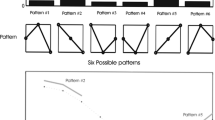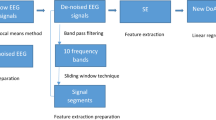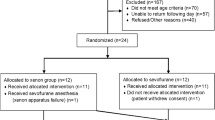Abstract
Objective. To study the usefulness of three electroencephalographic descriptors, the average median frequency, the average 90% spectral edge frequency, and a bispectral variable were used with the anesthetic concentrations in estimating the depth of anesthesia.Methods. Four channels of raw EEG data were collected from seven mongrel dogs in nine separate experiments under different levels of halothane anesthesia and nitrous oxide in oxygen. A tail clamp was used as the stimulus and the dog was labeled as a non-responder or responder based on its response. A bispectral variable of the EEG (just before a tail clamp) and the estimated MAC level of halothane and nitrous oxide combined were the two features used to characterize a single data point. A neural network analysis was done on 48 such data points. A second neural network analysis was done on 47 data points using average 90% spectral edge frequency and the estimated MAC level. The average median frequency of EEG was also evaluated, although a neural network analysis was not done.Results. The first neural network needed nine weights in order to train and correctly classify all of the 12 points in the training set under a training tolerance of 0.2. It could correctly classify all of the remaining 36 data points as either belonging to responders or non-responders. A cross-validation procedure, which estimated the overall performance of the network against future data points, showed that the network misclassified two out of the 48 data points. The second neural network needed 25 weights in order to train and classify correctly all of the 26 points in the training set under a tolerance of 0.2. It was later able to classify all of the 21 points of the test group correctly.Conclusions. The bispectral variable seems to reduce the nonlinearity in the boundary separating the class of non-responders from the class of responders. Consequently, the neural network based on the bispectral variable is less complex than the neural network that uses a power spectral variable as one of its inputs.
Similar content being viewed by others
References
Schwilden H, Stoeckel H. Quantitative EEG analysis during anaesthesia with isoflurane in nitrous oxide at 1.3 and 1.5 MAC. Brit J Anaesth 1987; 59: 738–745
Rampil I, Matteo R. Changes in EEG spectral edge frequency correlate with the hemodynamic response to laryngoscopy and intubation. Anesthesiology 1987; 67: 139–142
Drummond JC, Brann CA, Perkins DE, Wolfe DE. A comparison of median frequency, spectral edge frequency, a frequency band power ratio, total power and dominance shift in the determination of depth of anesthesia. Acta Anaesth Scand 1991; 35: 693–699
Cooke JE, Scott JC. Theta ratio — a better correlate of anesthetic depth. Anesthesiology 1986; 65: A541
Shah NK, Long CW, Bedford RF. Delta-shift: An EEG sign of awakening during light isoflurane anesthesia. Anesth Analg 1988; 67: S206
Levy WJ. Power spectrum correlates of changes in consciousness during anesthetic induction with enflurane. Anesthesiology 1986; 64: 688–693
Huber PJ, Kleiner B, Gasser T, Dumermuth G. Statistical methods for investigating phase relations in stationary stochastic processes. IEEE Transactions on Audio and Electroacoustics 1971; 19: 78–86
Barnett TP, Johnson LC, Naitoh P et al. Bispectrum analysis of electroencephalogram signals during waking and sleeping. Science 1971; 172: 401–402
Kearse LA, Manberg P, Chamoun N, debros F, Zaslavsky A. Bispectral analysis of the electroencephalogram correlates with patient movement to skin incision during propofol/nitrous oxide anesthesia. Anesthesiology 1994; 81: 1365–1370
Kearse LA, Saini V, debros F, Chamoun N. Bispectral analysis of EEG may predict anesthetic depth during narcotic induction. Anesthesiology 1991; 75: A175
Sebel PS, Bowles S, Saini V, Chamoun N. Accuracy of EEG in predicting movement at incision during isoflurane anesthesia. Anesthesiology 1991; 75: A446
Vernon J, Bowles S, Sebel PS, Chamoun N. EEG bispectrum predicts movement at incision during isoflurane or propofol anesthesia. Anesthesiology 1992; 77: A502
Lien CA, Berman M, Saini V, Matteo RS, Sharp GJ, Chamoun N. The accuracy of the EEG in predicting hemodynamic changes with incision during isoflurane anesthesia. Anesth Analg 1992; 74: S187
Ning TK, Bronzino JD. Bispectral analysis of the rat EEG during various vigilance states. IEEE Trans Biomed Eng 1989; 36: 497–499
Veselis RA, Reinsel R, Sommer S, Carlon G. Use of neural network analysis to classify electroencephalographic patterns against depth of midazolam sedation in intensive care unit patients. J Clin Monit 1991; 7: 259–267
Watt RC, Navabi MJ, Scipione PJ, Hameroff SR, Maslana ES. Neural network estimation of anesthetic dose using EEG spectral signatures. Anesthesiology 1990; 73: A470
Sigl JC, Chamoun NG. An introduction to bispectral analysis for the electroencephalogram. J Clin Monit 1994; 10: 392–404
Ning TK, Bronzino JD. Autoregressive and bispectral analysis techniques: EEG applications. IEEE Eng Med Biol 1990; 47–49
Nikias CL, Raghuveer MR. Bispectrum estimation: A digital signal processing framework. IEEE Proc 1987; 75: 869–891
Lippman RP. An introduction to computing with neural nets. IEEE Acoustics Speech and Signal Processing 1987; 4–22
Hertz J, Krogh A, Palmer RG. Introduction to the theory of neural computation. Redwood City, CA: Addison-Wesley, 1991: 141–156
Redding RW. Canine electroencephalography. In: Hoerlin BF, ed. Canine neurology: Diagnosis and treatment. Philadelphia: WB Saunders, 1965: 55–70
Vishnoi R, Roy RJ. Adaptive control of closed circuit anesthesia. IEEE Trans Biomed Eng 1991; 38: 39–47
Eger EI, Saidman LJ, Brandstater B. Minimum alveolar anesthetic concentration: A standard of anesthetic potency. Anesthesiology 1965; 26 (6): 756–763
Muthuswamy J, Roy RJ. Bispectrum analysis of EEG of a dog to determine the depth under halothane anesthesia. Proc 19th IEEE Annual Northeast Bioeng Conf 1993; 5–6
Quasha AL, Eger El, Tinker JH. Determination and applications of MAC. Anesthesiology 1980; 53: 315–334
Hecht-Nielsbn R. Neurocomputing. Redwood City, CA: Addison-Wesley, 1991: 118–119
Mehrotra KG, Mohan CK, Ranka S. Bounds on the number of samples needed for neural learning. IEEE Trans Neural Networks 1991; 2: 548–558
Lenat DB. On automated scientific theory formation: A case study using the AM program. In: Hayes JE et al., eds. Machine Intelligence. New York: Halsted Press, 1977: 251–286
Ahmad S, Tesauro G. Scaling and generalization in neural networks: A case study. Proc Neural Info Processing Conf 1988; 1: 160–176
Zbinden AM, Peterson-Felix S, Thomson DA. Anesthetic depth defined using multiple noxious stimuli during isoflurane/oxygen anesthesia. II. Hemodynamic responses. Anesthesiology 1994; 80: 261–267
Dwyer RC, Rampil IJ, Eger EI, Bennett HL. The electroencephalogram does not predict depth of isoflurane anesthesia. Anesthesiology 1994; 81: 403–409
Rampil IJ, Laster MJ. No correlation between quantitative electroencephalographic measurements and movement response to noxious stimuli during isoflurane anesthesia in rats. Anesthesiology 1992; 77: 920–925
Author information
Authors and Affiliations
Rights and permissions
About this article
Cite this article
Muthuswamy, J., Roy, R. & Sharma, A. A study of electroencephalographic descriptors and end-tidal concentration in estimating depth of anesthesia. J Clin Monitor Comput 12, 353–364 (1996). https://doi.org/10.1007/BF02077633
Received:
Revised:
Accepted:
Issue Date:
DOI: https://doi.org/10.1007/BF02077633




